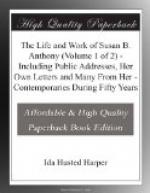During Miss Anthony’s stay at Canajoharie she went often to Albany and there made the intimate acquaintance of Abigail Mott and her sister Lydia, whose names are now a blessed memory with the leaders of the abolition movement that still remain. Their modest home was a rallying center for the reformers of the day, and here Miss Anthony met many of the noted men and women with whom she was to become so closely associated in the future. She reached home in 1849 to find a hot-bed of discussion and fermentation. The first rift had been made in the old common law, which for centuries had held women in its iron grasp, by the passage, in April, 1848, of the Property Bill allowing a married woman to hold real estate in her own name in New York. Previous to this time all the property which a woman owned at marriage and all she might receive by gift or inheritance passed into the possession of the husband; the rents and profits belonged to him, and he could sell it during his lifetime or dispose of it by will at his death except her life interest in one-third of the real estate. The more thoughtful among women were beginning to ask why other unjust laws should not also be repealed, and the whole question of the rights of woman was thus opened.
In 1848, Spiritualism may be said to have had its birth, and the remarkable manifestations of the Fox sisters brought numbers of people to Rochester, where they had-removed as soon as they began to be widely known. This form of religious belief soon acquired a large following, causing much controversy and great excitement.
The Society of Friends had divided on the slavery issue and Miss Anthony found her family attending the Unitarian church, which soon afterwards called William Henry Channing to its pulpit. Both he and Samuel J. May, the father of Unitarianism in Syracuse, became her steadfast friends and never-failing support in all the great work which was developed in later years.




